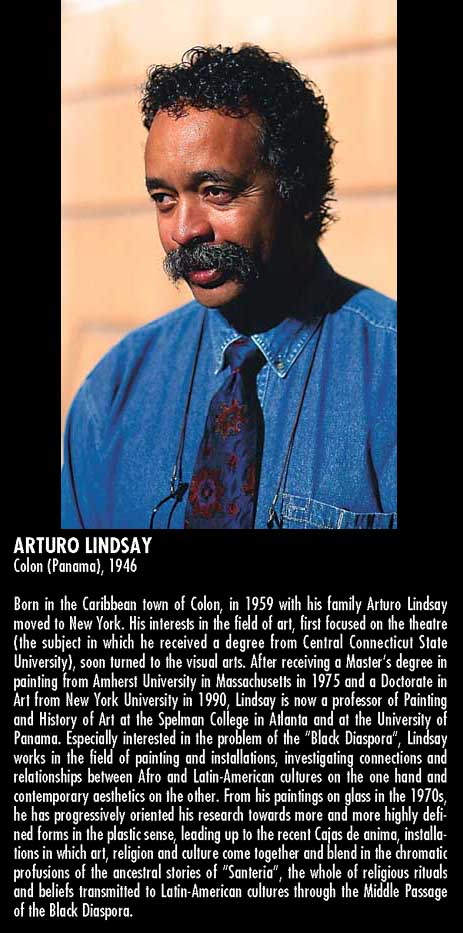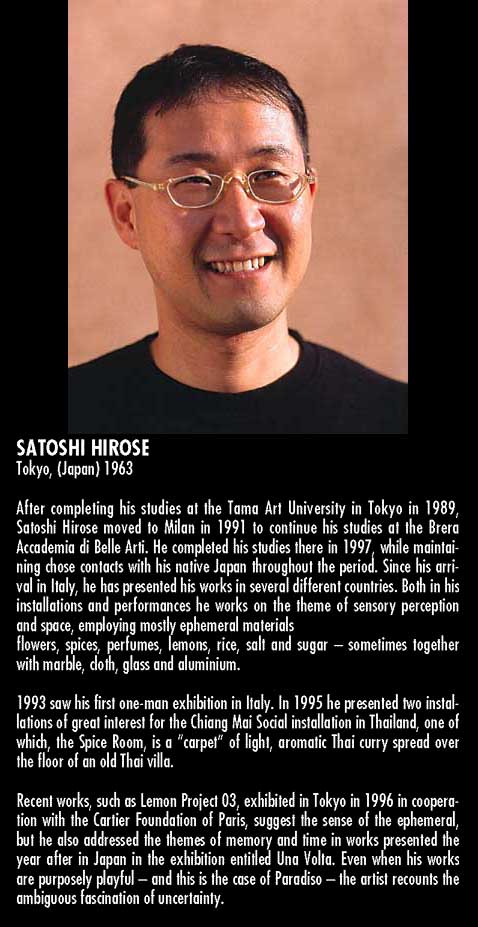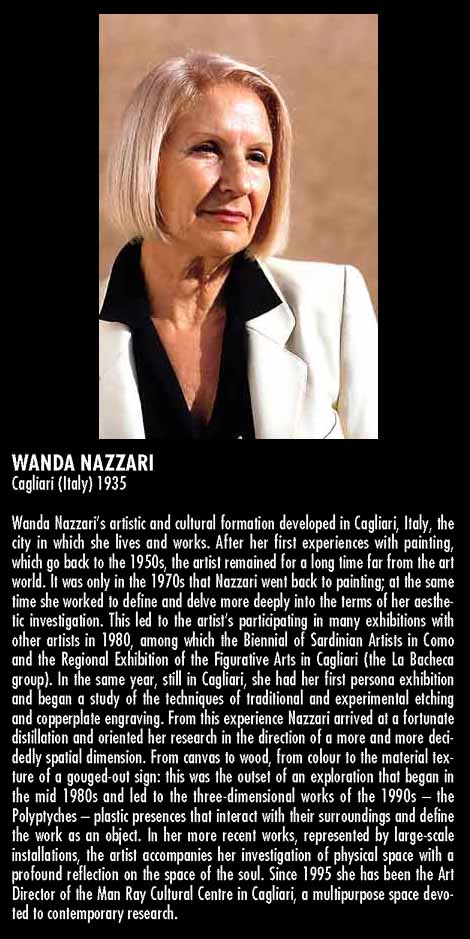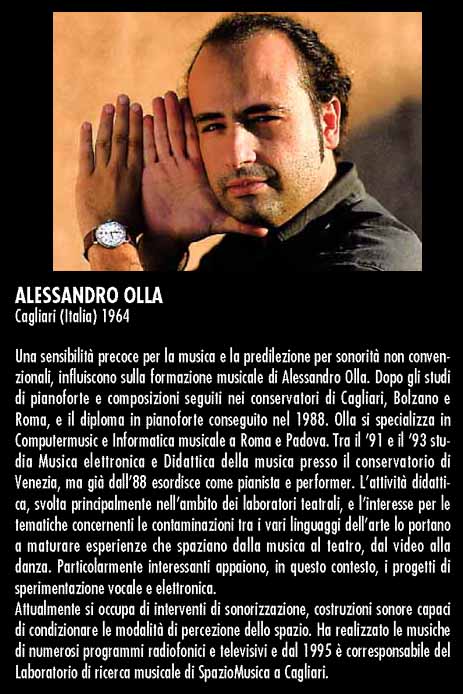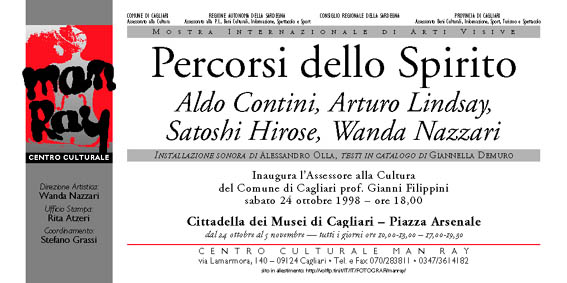

Percorsi dello Spirito
di Giannella Demuro
The multiform development of aesthetic processes in the last few years - which mark the end of the millennium, perhaps not casually - often consumes itself in the anxieties of a physical body whose identity has been torn apart, contaminated and raped by the ambiguous seduction of a new way of feeling, as defined in the biotechnological and medial sense.
Other times, the recognition of the ego is not feeling that turns out to be the radicalization of a bodily physicalness, but rather a reflection carried along on the silent traces left by time, an activity of thought that understands and weaves images and signs around itself: fragments of memory and history. Not a mimetic translation of the real, but an alchemic operation that distills from the real a cosmic, universal feeling.
The works in this exhibition, which belong to pathways of the spirit, are to be read from this viewpoint, one that cancels distances, even when strongly present, between different generations and cultures.
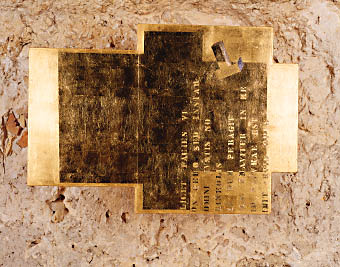
From the weft of time - that of history and the sacred - Aldo Contini rediscovers the preciousness of gold and the architectural values of the evocative retablo, the polyptych of the Catalan tradition of the 14th and 15th centuries. It is the cycle of the Magnificat. Works in wood, shaped to form crosses. Surfaces draped not by colour, but by the warm, metallic flashes of gold and silver, on which the artist creates geometries with unlikely perspectives, or writings - citations, dates, signatures of artists of the past - with the metal itself.
But in Contini's works the precious metal ceases to be a pure reference to religious sacrality. The artist plays with the caducity of his materials: against "true" gold - which, being unassailable, does not surrender to time - he opposes "false" gold, incapable of maintaining in the long run its original splendour. "True" silver, which easily becomes tarnished, is compared to "false" silver, which remains unaltered. Thus gold, the fascinating and unusual custodian of time, is called upon to represent a lay sacrality, the powerful dissonant tension of conscience on examining itself, it too capable, like gold, of resisting time.
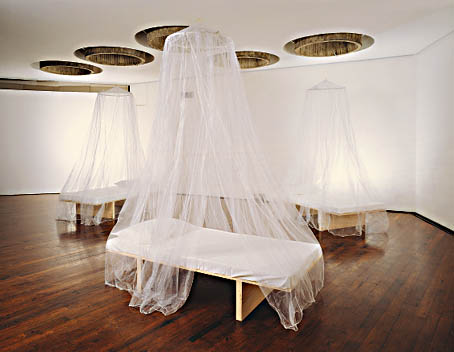
Not always visible, but in a certain sense still subtly perceivable, is the affinity that art itself creates among those who practise it. It is thus not surprising to discover that the ambiguity proposed by Contini in his comparison between true gold and false gold is understood and proposed in the same terms by Satoshi Hirose, an artist who has found the mainstream of his conceptual research in the very question of ambiguity and the transitoriness of the real.
Hirose's works are made up of the ephemeral, minimal constructions in precarious equilibrium, often entrusted to physically intense sensory perceptions - perfumes, flavours, lights - that bring into play the experience of those who observe and feel them, bringing back to his or her mind impressions, images, memories. And not only these.
The physicalness of the perception underscores the presence of space - empty, light, unstable - with which the work is called upon to interact. A space that becomes a passageway and a place for exchanges between the work and those who observe it, but also between the Self and the Other, between body and mind. On the concept of inter-ness is based the work produced for the Cittadella dei Musei. The impalpable mosquito netting that covers, but does not conceal, minimal beds destined to provide transitory rest but also, and above all, destined to provide reflection, mark the boundary/passage between external, public space and internal, private space, ambiguously visible and practicable, but still distinct.
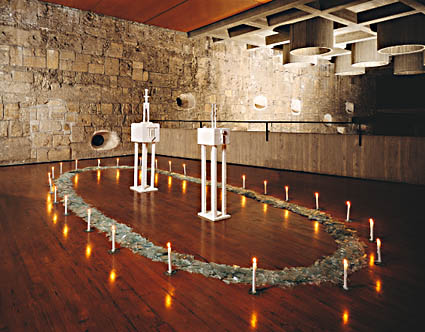
For Arturo Lindsay the space of his research is the land of his ancestors and its time is the time of an ancestral rituality, which the artist explores by going back to the roots of faith and collective identity. Son of the Black Diaspora, Lindsay feels his belonging to distinct cultural realities, and in this confused mixture (and search) for identity he blends together life, faith and art. The archaic symbols of a primitive culture, like those of "Santeria" are, for Lindsay, as they were for artists such as Picasso, Klee, Nolde and Moore, the signs of a profound spiritual pulsion and thus stimuli and entrances leading to the absolute. Santeria thus becomes the name given to a cycle of works of a strongly sacred nature - altars decorated with statuettes, candles and other small objects in the votive tradition, to which Middle Passage Memorial 2 also refers. In this work the altar is replaced by two white boxes raised from the ground - the cajas de anima - urns of the soul, destined to contain the souls of the dead - surrounded by a barrier (in the form of a boat) of broken glass, a symbolic synthesis of the body and its fragility. A metaphor of a voyage, of the "passage" of the Blacks from Africa to America, but also of a humanity whose emanation survives in the spirit and in art.
A reflection on the spirit is also that of Wanda Nazzari, conducted in a certain sense along the same lines as that of Arturo Lindsay. Nazzari's research has been oriented, especially in the last few years, towards the practise of a deepening introspection directly addressing the springs of faith, the Sacred Scriptures.
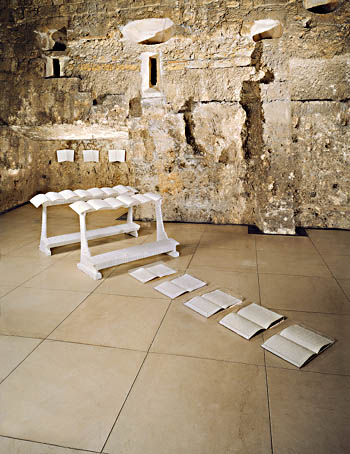
A meditation that takes place in the places of the soul: from the existential dimension of the Nidi, works in which the artist addresses the theme of human suffering, to the Croce, the image of supreme pain, to the large Ali, symbols of faith, and finally to the recent Rivelazione.
A semantic text with many symbolic references, Rivelazione is a work that creates a mystic space of intense suggestive power, in which the epiphany of the Invisible can be perceived. Torn bandages made of untreated canvas cover the wooden objects of contrition and pardon, which the artist has taken from liturgical practise, while the words in Hebrew taken from the Holy Texts - shadows carved meticulously - appear on the white pages that introduce and sustain the walk towards reconciliation. In the silence of the symbols and in the confrontation with reality the artist interprets the anxiety of the divine.
Another pathway is added to those represented in the works on exhibition. It is invisible, but clearly perceivable: it is the path traced by the sonorous constructions of Alessandro Olla, a reflection which, like those proposed by the other artists present, penetrates the spirit with the ethereal weight of thought.
(translation by David Nilson)


